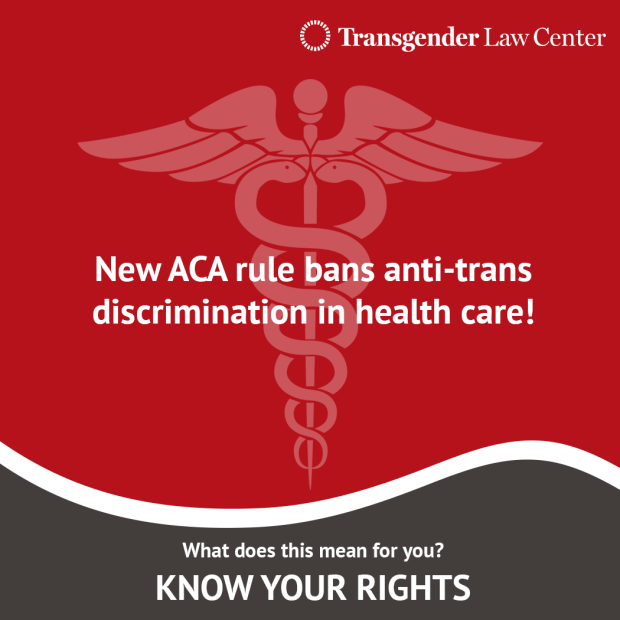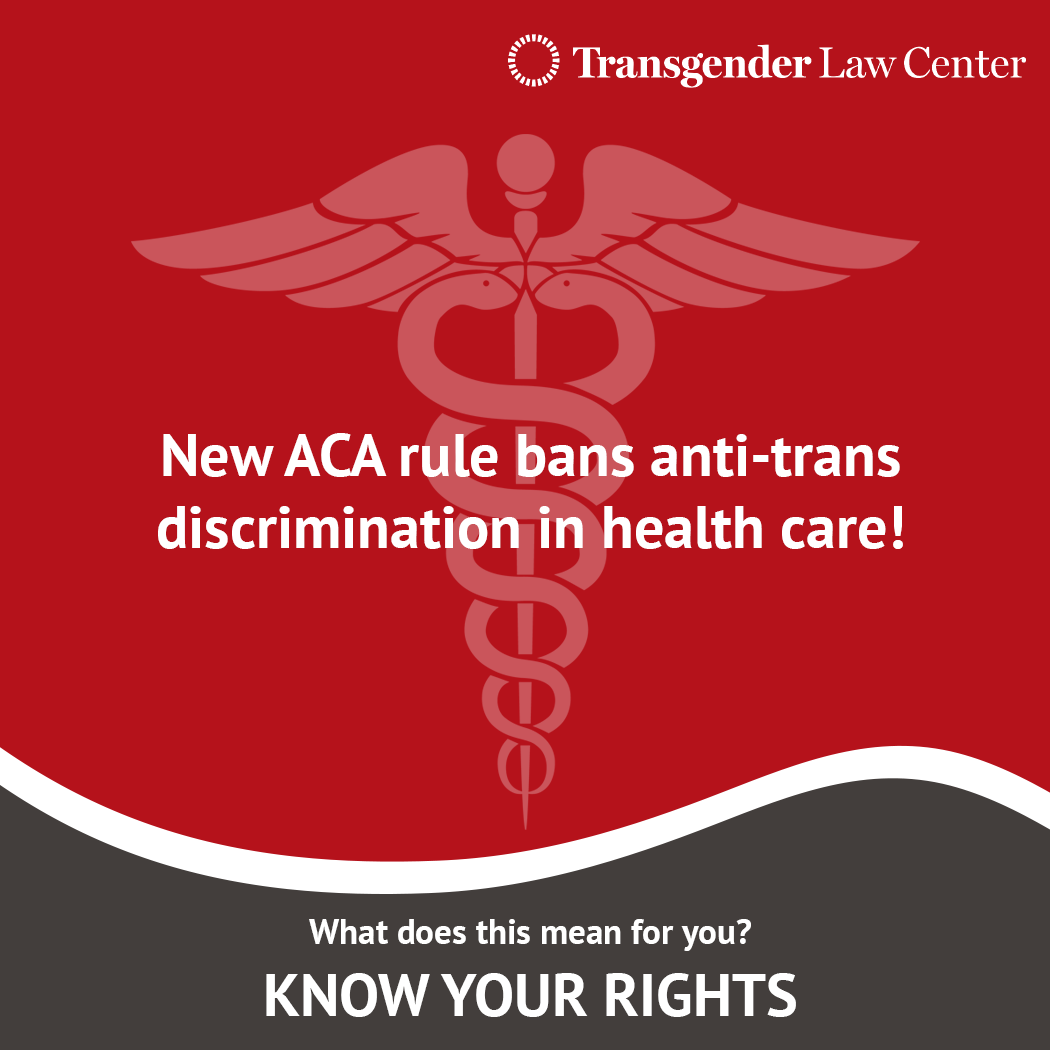 Today, the federal department of Health and Human Services’ Office of Civil Rights issued final regulations on Section 1557 of the Affordable Care Act. The rule specifically bans discrimination in most insurance coverage and the denial of health care on the basis of gender identity.
Today, the federal department of Health and Human Services’ Office of Civil Rights issued final regulations on Section 1557 of the Affordable Care Act. The rule specifically bans discrimination in most insurance coverage and the denial of health care on the basis of gender identity.
“This groundbreaking rule makes clear that health care discrimination against LGBT people—particularly transgender and gender non-conforming people—is unlawful under existing federal law,” said Transgender Law Center Executive Director Kris Hayashi in response to the rule. “Nobody should face harassment or discrimination in the doctor’s office or be denied the medical care they need just because of who they are.”
Most of the rule’s provisions go into effect July 18, 2016. When the rules were first proposed in September, Transgender Law Center detailed what these regulations would mean in our post, “What you need to know – and do – to make the Affordable Care Act work for you.” In addition to Transgender Law Center’s fact sheet below, there is an excellent FAQ from the National Center for Transgender Equality containing details that might be helpful.
It’s important to note that the rules are not only for LGBT people – section 1557 provides protections based on race, color, national origin, sex, age, and disability. Protections for LGBT people come under the category of sex discrimination, which includes gender identity and sex stereotyping.
Our fact sheet below — and downloadable here — explains key parts of the rule, including scope, effective dates, and how to take action if you’ve experienced discrimination.
- The rule prohibits discrimination on the basis of sex, which includes “pregnancy, false pregnancy, termination of pregnancy, or recovery therefrom, childbirth or related medical conditions, sex stereotyping, and gender identity” (p. 337). Who falls under this definition?
- Transgender and gender non-conforming people: in their definition of sex, OCR explicitly includes gender identity, which they define as “an individual’s internal sense of gender, which may be male, female, neither, or a combination of male and female, and which may be different from an individual’s sex assigned at birth.” (p. 336) They also define sex stereotypes to include characteristics of gender expression such as “behavior, clothing, hairstyles, activities, voice, mannerisms, or body characteristics This definition clearly includes transgender and gender non-conforming people, including people who identify as genderqueer and non-binary.
- Intersex people: OCR states that “the prohibition on sex discrimination extends to discrimination on the basis of intersex traits or atypical sex characteristics,” (p. 50), which could not be any clearer.
- Lesbian, gay, and bisexual people: while the rule does not name sexual orientation specifically as a protected class, it does make clear that the most common ways LGB people are singled out for discrimination – sex stereotyping and association with someone known to be LGBT—are unlawful. OCR notes that sex stereotypes include those about “sexual attraction and sexual behavior or about deviations from ‘heterosexually defined gender norms’” (p. 52-53). It’s important to note that these protections apply whether or not a person identifies with the words “lesbian”, “gay”, or “bisexual”, and encompasses a broad spectrum of people, including men who have sex with men and people whose partners are transgender.
- The rule applies to discrimination in: (1) health settings that receive federal financial assistance, (2) every health program administered by the Department of Health and Human Services, and (3) every health program administered by Title I of the Affordable Care Act (p. 330-331). What contexts does this apply to?
- Most hospitals, clinics, pharmacies, labs, and HIV testing sites nationwide. This can be as a result of a facility’s participation in Medicaid or Medicare programs, through direct grants or loans, by being a Federally Qualified Health Center, through participation in the Ryan White Care Act, because of CDC funds for HIV prevention programs, or any number of other ways they might receive federal funds.
- Most types of health insurance and coverage, including Medicaid, Medicare, AIDS Drug Assistance Programs (ADAP), and individual insurance plans purchased through a state or federal health exchange. The rule also applies to insurance plans purchased directly through an insurance carrier or that is an employer-sponsored health insurance plan, when any part of the insurance carrier receives federal financial assistance. For example, since Aetna sells insurance plans through state health exchanges, it receives federal financial assistance in the form of premium subsidies. This means that discrimination is prohibited in any other insurance product that Aetna sells.
- The new rule says that you cannot “be excluded for participation in, be denied the benefits of, or otherwise be subjected to discrimination under any health program or activity to which [the rule] applies” (p. 345). What counts as discrimination?
- In clinical settings: Many acts of overt and covert discrimination are prohibited under the new rule. Some examples include: a provider or facility refusing to treat you, refusing to use your name and pronoun correctly, performing unnecessary or aggressive genital examinations, refusing to room you according to your gender identity, a pharmacist refusing to fill your prescription for hormones. There are many other ways discrimination can show up in a health setting as well.
- In insurance: The denial or limitation of health care coverage for specific health services related to gender transition if the denial, limitation, or restriction results in discrimination against a transgender person. The rule states that it is unlawful for an insurance carrier to “have or implement a categorical coverage exclusion or limitation for all health services related to gender transition” (p. 354) when the insurer falls under one of the categories above. This means that blanket exclusions for transition-related care, which have been banned in 14 states and DC so far, are now unlawful nationwide in private insurance as well as Medicaid programs. This provision also applies to self-funded employer plans when the employer primarily provides health services (e.g, hospitals, clinics, skilled nursing facilities).
While banning the exclusion is not the same as requiring affirmative coverage, it does mean that if an insurance plan provides coverage for a treatment for a non-transgender person, they cannot then deny it for a transgender person on the basis of their transgender status. This is the same rationale that has been applied in the 15 jurisdictions that have implemented non-discrimination in health insurance so far, which have opened the door to many transgender people to access life-saving care for the first time, including hormone therapy and certain surgeries.
If a covered health plan currently has exclusions, it has until the first day of the first plan year beginning January 1, 2017 to remove the exclusion.
- How do I exercise my rights if I experience discrimination?
- Whether the discrimination has occurred in a clinical or insurance context, the process is the same—file a complaint with the HHS Office of Civil Rights, including details of what happened and when. OCR will then review your claim and take enforcement action. In the case of an unlawful insurance denial, OCR can order the insurer to reverse the denial. You may also have additional rights under state or local laws, depending on where you live. If you’re not sure how to put together your complaint, Transgender Law Center’s legal helpline can help you find the right information or connect you with a local attorney who can help.
In the case of an employer that is not primarily a health setting and has a self-funded employee health plan that has a categorical exclusion for transition-related care, OCR will refer discrimination claims to the Equal Employment Opportunity Commission (EEOC) to determine if the employer has violated Title VII of the 1964 Civil Rights Act (in 2013, the EEOC ruled that gender identity is a protected class for employment discrimination under Title VII, in Transgender Law Center’s case, Macy v. Holder). For more about self-funded plans, see our 2013 FAQ on California’s ban on health insurance exclusions.
The Department of Health and Human Services has made a clear and unequivocal statement that transgender and gender non-conforming people deserve access to safe, affirming health care. While it may take several years for legal challenges to the Affordable Care Act to subside, we know that, for the first time, the federal government is taking a stand to protect our communities that is much more than a gesture. The rule from OCR has the power to effect real change in real people’s lives – as long as community members, providers, and insurance carriers are aware of their rights and obligations. So don’t stop here- share this information with your friends, family members, coworkers, policy makers, and health care providers far and wide.

